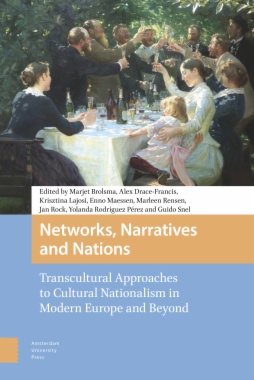Do narratives make nations, and if so, did networks make this happen? The notion that national and other group identities are constructed and sustained by narratives and images has been widely postulated for several decades now. This volume contributes to this debate, with a particular emphasis on the networked, transnational nature of cultural nation-building processes in a comparative European and sometimes extra-European context. It gathers together essays that engage with objects of study ranging from poetry, prose, and political ideas to painting, porcelain, and popular song, and which draw on examples in Icelandic, Arabic, German, Irish, Hungarian, and French, among other languages. The contributors study transcultural phenomena from the medieval and early modern periods through to the modern and postmodern era, frequently challenging conventional periodizations and analytical frameworks based on the idea of the nation-state.
- Cover
- Table of Contents
- Introduction
- Of Networks, Narratives and Nations
- Part I: National Questions
- 1. National Stereotypes in Early Modern Europe
- 2. Constructed or Primordial?
- The European Nation-State
- 3. Nationalism and the Rhine
- 4. Cultural Nationalism beyond Europe
- Genealogies of Mankind, Imperial Custodianships and Anticolonial Resistance
- Part II: Networked Nations
- 5. Firebrand Folklore
- Musical Memory and the Making of Transnational Networks
- 6. The Nation as a Network
- Rizaeddin Fakhreddinov’s Islamic Biographies
- 7. A Network in Search of an Alternative Modernity
- Artists’ Colonies in Europe (1870–1914)
- 8. A Dutch Journal with a European Programme
- Part III: Canonicity and Culture
- 9. Cultural Nationalism and the Invention of Dutch Literary Icons
- 10. Colonial Legacies in European Folklore Studies
- 11. The Canonization of the Artisan around 1900
- 12. Sigurður Guðmundsson and Jón Árnason’s Icelandic Folktales
- 13. Songs His Mother Taught Him
- Émile Legrand’s Collection of Lacemakers’ Ballads
- 14. The Genesis of a National Product
- Henry Havard and the Renewed Interest in Delftware, 1850–1920
- Part IV: Historicity and Narrative
- 15. Travelling Westwards
- Finding Europe in the Irish Middle Ages
- 16. Finding Oneself within Germania
- Karl Viktor Mühlenhoff’s Reading of Widsith
- 17. The Faces of Crisis
- Rethinking a Key Concept in View of the Transnational Intellectual History of Europe
- 18. The Extension of Traditions
- King Stephen I of Hungary and the Politics of Cultural Nationalism
- 19. The Buried Tombstone, the Melting Iceberg, and the Random Bullet
- History, Memory and Antagonism in Ireland
- 20. Reconstituting the European Historical Novel in Latin America
- Mario Vargas Llosa in the Backlands of Brazil
- Part V: Imagology, Identity and Alterity
- 21. The Shape of Things to Come
- Thomas Pennant’s Tour of Ireland in 1754
- 22. Auto-exoticism and the Irish Colonial Landscape
- George Petrie’s Paintings of Clonmacnoise (1828) and Dún Aengus (1827)
- 23. Ordinary Eyesight?
- Cultural Comparisons between Ireland and Wales
- 24. European Constructions of the Asian East in the Novels of John Buchan
- 25. Prerequisites to the Study of “Social Perception”
- Empathy and Immunity to Nationalism
- 26. Considerations of an Imagined Land
- Acknowledgments
- List of Contributors
- Index
- List of illustrations
- Fig. 1.1 Völkertafel (Panel of the Peoples, c.1720–30). Austrian Museum of Folk Life and Folk Art, Vienna. Image: Wikimedia Commons.
- Fig. 8.1 Title page of De Muzen (1835).
Private Collection.
- Fig. 9.1 “Jantje zag eens pruimen hangen” (Johnny Saw Some Fine Plums Hanging). Hieronymus van Alphen, Kleine gedigten voor kinderen (Poetry for Children, 1783). Image: Wikimedia Commons.
- Fig. 11.1 Photograph of an artisanal cheesemaker at work at the Village Suisse at the Swiss National Exhibition in Geneva in 1896. Collection Albin Salamin. Image: NotreHistoire.ch, public domain.
- Fig. 14.1 Bust of King-Stadtholder William III (attributed to Lambertus van Eenhoorn, c.1700). A showpiece from Loudon’s bequest, formerly the property of Queen Sophia. Rijksmuseum, Amsterdam. Image: Wikimedia Commons.
- Fig. 18.1 Peter Johann Nepomuk Geiger, The Coronation of St Stephen (c.1870). Lithograph, Hungarian National Museum, Budapest. Image: Wikimedia Commons.
- Fig. 21.1 Map of Thomas Pennant’s journey in Ireland, 1754. Map made by David Parsons.
- Fig. 22.1 Ruins of Clonmacnoise, King’s County. Engraving after George Petrie, from J. N. Brewer, Beauties of Ireland (London: Sherwood, Gilbert & Piper, 1826), vol. 2, no pag.
- Fig. 22.2 George Petrie, The Last Circuit of Pilgrims at Clonmacnoise (1826). Richard Wood Collection, University of Limerick.
- Fig. 22.3 George Petrie, Dun Aengus Fort, Inismore, Aran Islands (c.1827). National Gallery of Ireland.
- Fig. 24.1 Cover of the first edition of John Buchan, Greenmantle (London: Hodder & Stoughton, 1916).

